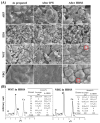Physical Properties and Biofunctionalities of Bioactive Root Canal Sealers In Vitro
- PMID: 32899641
- PMCID: PMC7559325
- DOI: 10.3390/nano10091750
Physical Properties and Biofunctionalities of Bioactive Root Canal Sealers In Vitro
Abstract
Calcium silicate-based bioactive glass has received significant attention for use in various biomedical applications due to its excellent bioactivity and biocompatibility. However, the bioactivity of calcium silicate nanoparticle-incorporated bioactive dental sealer is not much explored. Herein, three commercially available bioactive root canal sealers (Endoseal MTA (EDS), Well-Root ST (WST), and Nishika Canal Sealer BG (NBG)) were compared with a resin-based control sealer (AH Plus (AHP)) in terms of physical, chemical, and biological properties. EDS and NBG showed 200 to 400 nm and 100 to 200 nm nanoparticle incorporation in the SEM image, respectively, and WST and NBG showed mineral deposition in Hank's balanced salt solution after 28 days. The flowability and film thickness of all products met the ISO 3107 standard. Water contact angle, linear dimensional changes, and calcium and silicate ion release were significantly different among groups. All bioactive root canal sealers released calcium ions, while NBG released ~10 times more silicon ions than the other bioactive root canal sealers. Under the cytocompatible extraction range, NBG showed prominent cytocompatibility, osteogenecity, and angiogenecity compared to other sealers in vitro. These results indicate that calcium silicate nanoparticle incorporation in dental sealers could be a potential strategy for dental periapical tissue regeneration.
Keywords: angiogenic; bioactive; osteogenic induction; root canal sealers; silicate ions.
Conflict of interest statement
The authors declare no conflict of interest.
Figures






References
-
- Hargreaves K.M., Berman L.H. Cohen’s Pathways of the Pulp Expert Consult. Elsevier Health Sciences; Amsterdam, The Netherlands: 2015.
-
- ISO . ISO 6876:2012 Dentistry—Root Canal Sealing Materials. International Organization for Standardization; Geneva, Switzerland: 2012.
-
- Grossman I., Oliet S., Del Rio E. Endodontic Practice. 11th ed. Lea and Fabringer; Philadelphia, PA, USA: 1988. pp. 145–155.
Grants and funding
LinkOut - more resources
Full Text Sources
Miscellaneous

